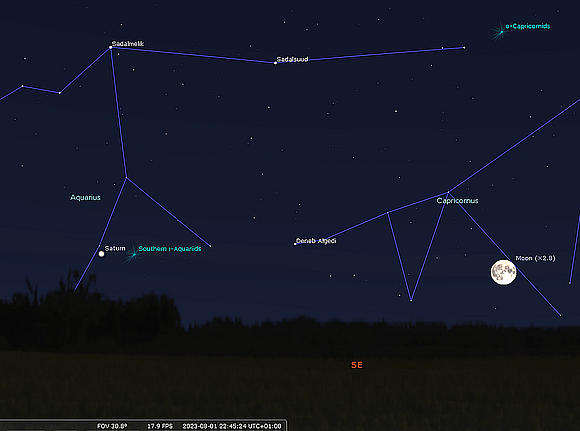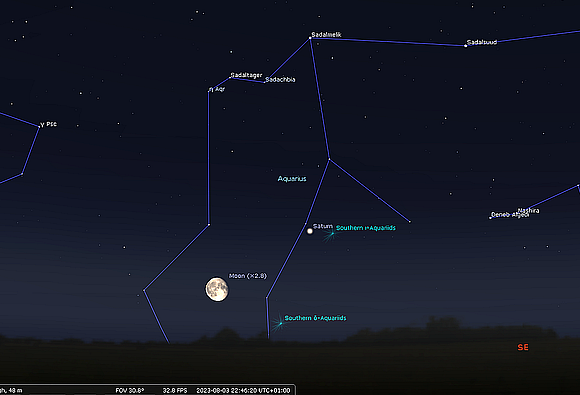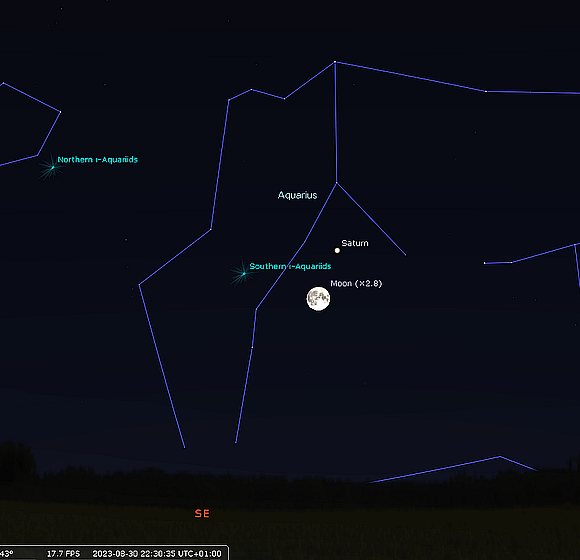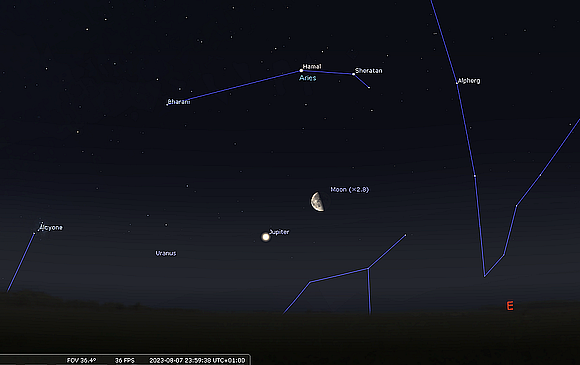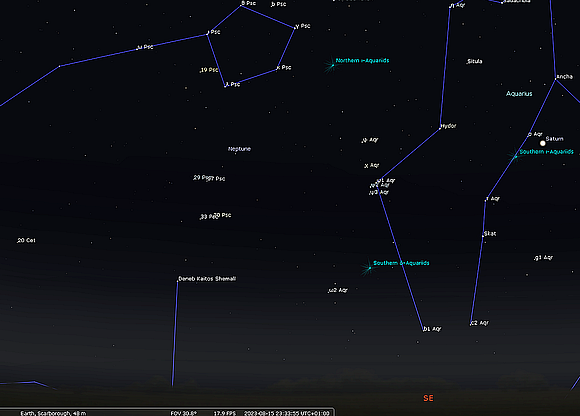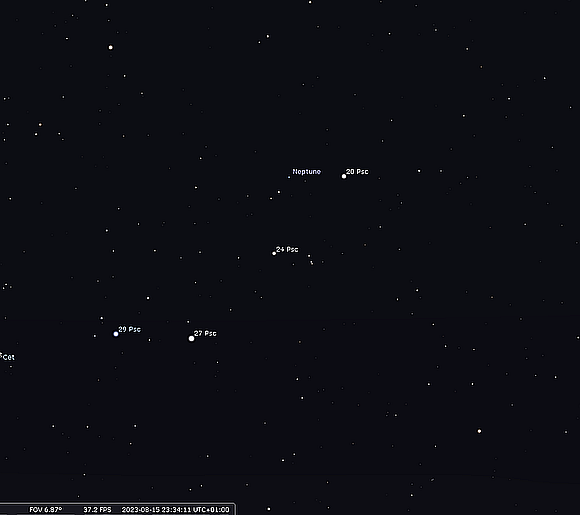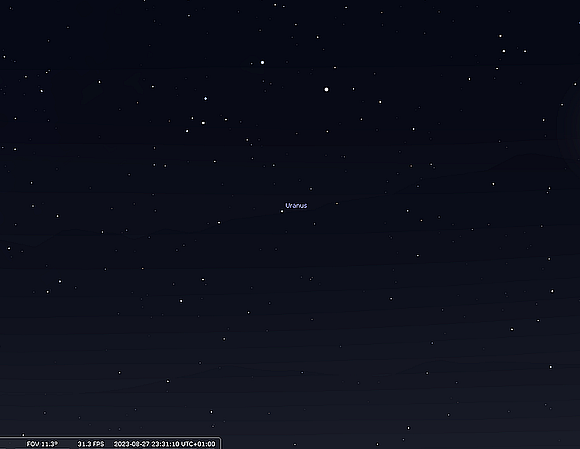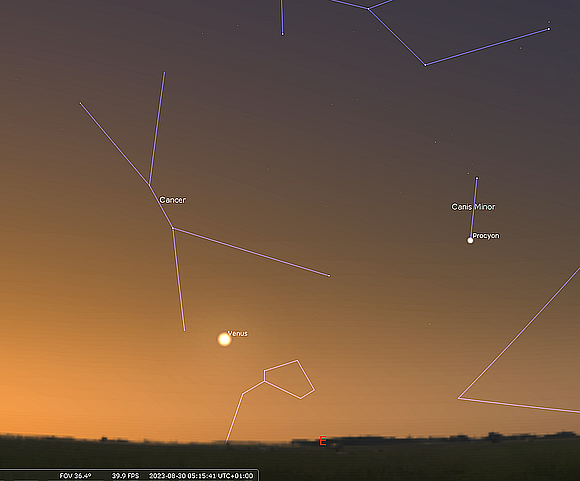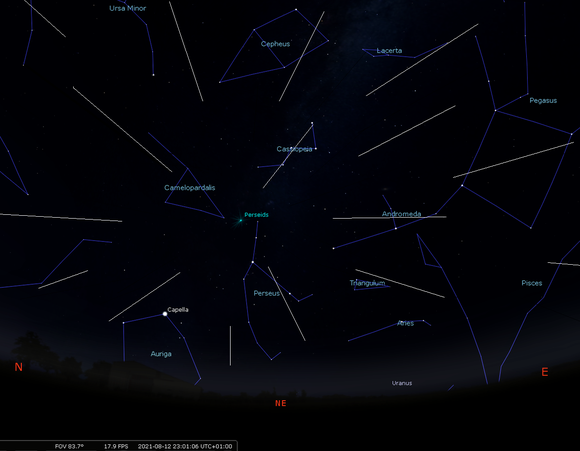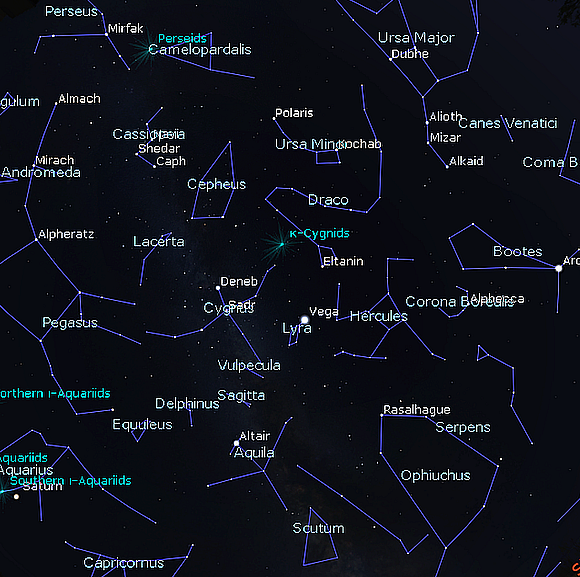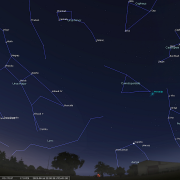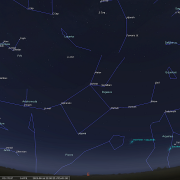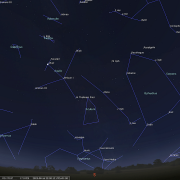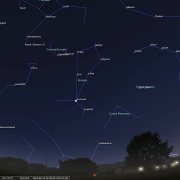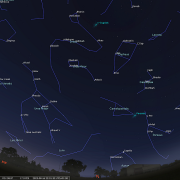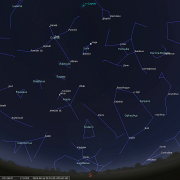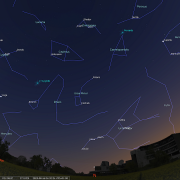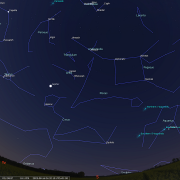In this month's Sky Notes:
- Planetary Skylights.
- August Meteors - Perseids and NCL reports.
- August Night Sky.
- August 2023 Sky Charts.
Planetary Skylights: A Brief Guide to August's Night Sky
Saturn is now a bonafede evening object coming to opposition later in the month. Jupiter follows Saturn by an hour and will be better placed in the evening sky by the end of August. Uranus and Neptune visible overnight. Venus returns to dawn sky.
 Saturn is rising shortly before 22:00hrs at the start of August and by 20:00hrs at the end of the month. Saturn reaches opposition on Aug 27th, visible from sunset to sunrise, culminating to the south shortly after midnight some 23 degrees above the Horizon. Saturn is currently 11 degrees below the celestial equator and won't cross into the northern half of our sky until 2026, becoming increasingly better placed for observation from our shores. Attaining a magnitude of +0.42 during its opposition period, the creamy white hue of Saturn will appear quite conspicuous amongst the faint stars of southern Aquarius where it currently resides, a region of the sky devoid of brighter stars.
Saturn is rising shortly before 22:00hrs at the start of August and by 20:00hrs at the end of the month. Saturn reaches opposition on Aug 27th, visible from sunset to sunrise, culminating to the south shortly after midnight some 23 degrees above the Horizon. Saturn is currently 11 degrees below the celestial equator and won't cross into the northern half of our sky until 2026, becoming increasingly better placed for observation from our shores. Attaining a magnitude of +0.42 during its opposition period, the creamy white hue of Saturn will appear quite conspicuous amongst the faint stars of southern Aquarius where it currently resides, a region of the sky devoid of brighter stars.
Through the eyepiece Saturn is a wonderful sight, although the tilt of the ring system is now shrinking. The rings are currently tilted by 9 degrees, which will increase by one degree later in the year, before closing again. The next ring plane crossing will occur in 2025. Under good seeing conditions typical 100mm (4") scopes will show the outermost ring (ring A) and the broader ring B on the inside. Instruments of 150mm (6") and above will be required to detect the Cassini division, the major gap between ring A and B.
Saturn has many moons (at least 80), most of which are very small, but it has a clutch of 'good sized' moons and of course Titan, Saturn largest moon, visible in all instruments as a speck of light nearby. As the rings continue to close, observation of several more moons, including Dione, Tethys, Rhea, Enceladus, Mimas, and Janus will become increasingly more frequent - though still specks. On Aug 3rd and again on the 30th, Saturn resides less than 2.5 degrees from the Moon.
 Jupiter follows Saturn into the late evening sky by 90 minutes or so and is still best placed post-midnight for this month. By mid-August Jupiter will be rising at 23:00hrs and an hour earlier by the end of the month low to the ENE. Jupiter is much brighter than Saturn, reaching mag -2.49 by the months end, so really cannot be missed. Residing in Aries, Jupiter is gaining in altitude each year now, affording steady seeing for observers in more northern latitudes.
Jupiter follows Saturn into the late evening sky by 90 minutes or so and is still best placed post-midnight for this month. By mid-August Jupiter will be rising at 23:00hrs and an hour earlier by the end of the month low to the ENE. Jupiter is much brighter than Saturn, reaching mag -2.49 by the months end, so really cannot be missed. Residing in Aries, Jupiter is gaining in altitude each year now, affording steady seeing for observers in more northern latitudes.
Through the eyepiece Jupiter is a whopping 40 arc seconds in diameter (which is noticeably oblate) making for pleasing observations even with a small telescope. Look for the darker banding, great red spot, and attendant Galilean moons in close proximity to the disk. Overnight of Aug 7/8th look for a last Qtr. Moon in conjunction with Jupiter making for a fine sight.

 Neptune and Uranus are both now visible throughout the very late evening and overnight, becoming better placed later in the month. Neptune resides around 15 degrees eastwards of Saturn, below the faint loop of stars marking the western fish of Pisces. The nearest 'bright' star is 5th magnitude 20 psc half a degree to the right. Neptune itself is 7th magnitude appearing as a tiny 2.5 arc-second disc through the eyepiece. To glimpse this, you will require a 100mm (4") aperture at least.
Neptune and Uranus are both now visible throughout the very late evening and overnight, becoming better placed later in the month. Neptune resides around 15 degrees eastwards of Saturn, below the faint loop of stars marking the western fish of Pisces. The nearest 'bright' star is 5th magnitude 20 psc half a degree to the right. Neptune itself is 7th magnitude appearing as a tiny 2.5 arc-second disc through the eyepiece. To glimpse this, you will require a 100mm (4") aperture at least.
Uranus lies less than 6 degrees left of Jupiter and a similar distance to the right of the Pleiades star cluster. Uranus is mag +5.8 and is of a soft green/grey hue. Technically visible to the naked eye, in reality an aperture of 75-80mm (3") is needed to spot the tiny 3.5-degree disk.
 Venus makes a swift return to the dawn sky towards the end of August. The brilliant 'morning star' will certainly be conspicuous in the dawn twilight almost due east, blazing forth at magnitude -4.6 magnitude. Through the eyepiece Venus exhibits a slender crescent phase. The 1st mag star - Procyon sits off to the right.
Venus makes a swift return to the dawn sky towards the end of August. The brilliant 'morning star' will certainly be conspicuous in the dawn twilight almost due east, blazing forth at magnitude -4.6 magnitude. Through the eyepiece Venus exhibits a slender crescent phase. The 1st mag star - Procyon sits off to the right.
Finally, there are two Full Moon's in August, both are supermoons. These occur when a Full Moon occurs near the Moon’s closest orbital point to Earth on its slightly elliptical orbit around it. The second supermoon on the 30th is a 'blue' supermoon, being the largest supermoon of the year, some 33 arc-minutes and 37 arc-seconds in diameter and second Full Moon in the month. The first Full Moon on August 1st is the 2nd smallest supermoon this year, 33 arc-minutes and 29 arc-seconds in diameter. The 'blue' supermoon is relatively uncommon, so have no doubt the media will be going all out highlighting the fact!
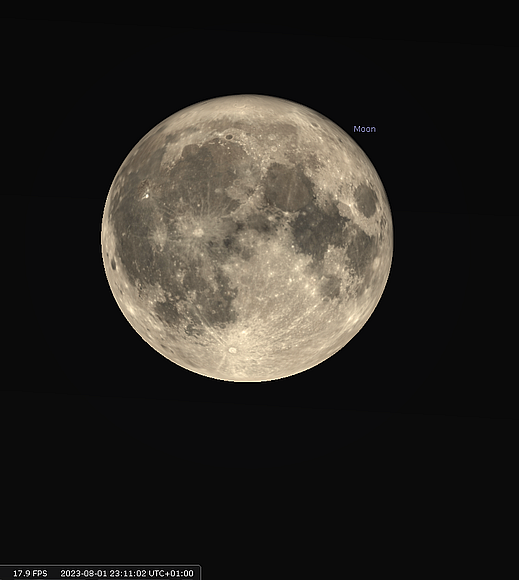
The supermoon on Aug 1st is second smallest this year.
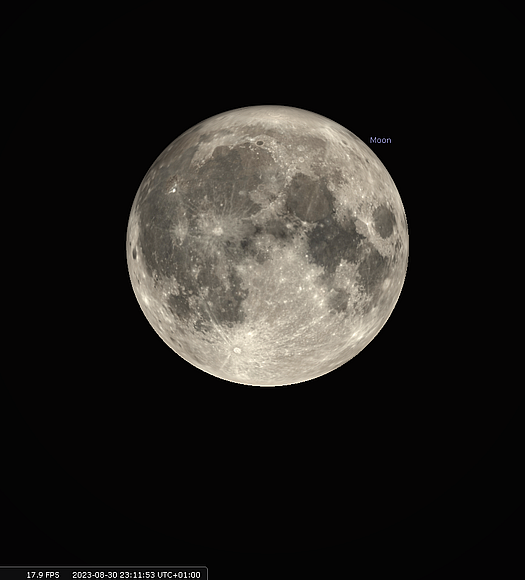
The second 'blue-supermoon' on the 30th is the largest of 2023.
August Meteors - The Perseids
Meteor activity is rather low during summer, with one, glorious exception; the Perseids, one of the more prolific meteor showers and without doubt the most widely observed by the public. The Perseids are active from late July until after mid-August, with activity highest from Aug 8th-15th. The shower normally reaches a peak overnight of Aug 12-13th. Sometimes known as "The tears of St. Lawrence"; the martyred Christian deacon whose feast day falls on Aug 10th, just two days before the Perseids peak, these particular ‘tears’, like most meteor showers, are composed of debris deposited over many thousands of years by periodic comets.
Perseids are associated with the periodic comet Swift Tuttle which has an orbital period of around 133 years. It appeared last in 1992 when enhanced rates were seen. It is widely perceived amongst the public that meteors are quite substantial in size, but this is not so, Perseid meteoroids are not dissimilar in size and density to that of instant coffee granules with the occasional pea or marble sized fragment. Each August, Earth encounters various strands of the Swift-Tuttle debris stream giving rise to the eagerly anticipated shooting stars.
Penetrating the upper atmosphere some 60 miles up, Perseid 'meteoroids' reach speeds of 43miles/second, interacting with atoms as they push through the air, a process known as ablation, before becoming ionised and releasing a packet of light. It is this brief luminous flash we call a meteor. Particularly bright examples often leave behind persistent ionisation trails in their wake, the classic shooting star.
The radiant of the shower: the location in the sky from which the meteors appear to emanate, lies within the constellation of Perseus, which in August is rising in the northeast during the evening and is best placed around 07:00hrs. This year the shower is expected to reach peak activity at 09:00 BST on 13 August 2023, and so the best displays might be seen before dawn on 13 August. Under ideal conditions the zenith hourly rate (ZHR) for the Perseids is typically 80-120, but actual observed rates by one person will be a third of this.
Observers up before dawn (say around 04:00) would expect to see perhaps 30 - 50 meteors per hour. Late evening of Aug 12th will likely yield around 20 per hour. Do not just observe on this date only - the night of 11/12th may also be productive. Try to observe in areas of the sky a good hand span away from Perseus and between 40-70 degrees above the horizon. We hopefully will be on the West Cliff for the Regatta evening star party events - so fingers crossed we spot a good few.
Noctilucent Cloud Watch
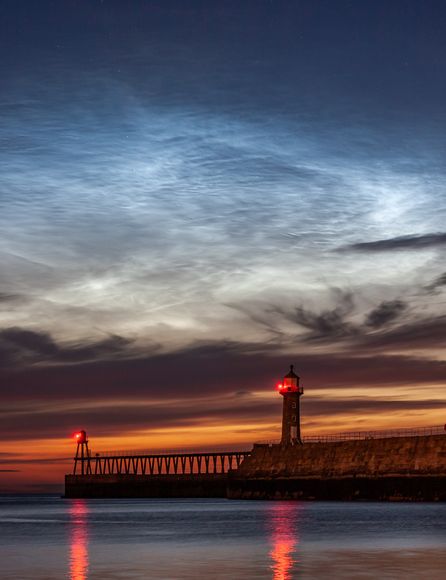
Noctilucent cloud - June 15th - 2021. Image Richard Randle
It has been a very disappointing NCL season, with hardly any decent sightings of Noctilucent cloud. Sightings are possible in August, usually early in the month, so don't give up yet.
August Night Sky
August sees the resumption of true astronomical twilight, the deepest level of twilight, increasing so by the month's end. Amateur astronomers will then be dusting off their telescopes in preparation for lengthy periods of true dark sky observing. It is still post 21:00hrs before the brightest stars emerge as the month starts, Arcturus in the west and Vega overhead, first to emerge, followed by Deneb (high to the east), Altair (midway up in the south) and completing this initial clutch of stellar luminaries, Capella low to the north.
By 22:30hrs most of the fainter stars visible to the naked eye complete the celestial jigsaw puzzle, making constellation recognition that much easier. You will then locate the familiar saucepan outline of the ‘Plough’ (part of Ursa Major, the Great Bear) high in the NW, the arc of its handle pointing down in the direction of brilliant star Arcturus in Boötes the Herdsman. Note the delicate starry circlet of Corona Borealis - the Northern Crown, situated to the upper left of Arcturus. Its chief star Alphecca acts as centre stone of this celestial tiara.
Much of the SW aspect is occupied by just two constellations, the sprawling figure of Hercules occupies the region higher in the SW - a little above Corona and is best identified by the ‘keystone’ asterism. Below Hercules extending down toward the WSW horizon, the huge and rather indistinct constellation of Ophiuchus, the serpent bearer stands. As dusk falls in this direction you may spy the orange hue of Antares in Scorpius just above the SW horizon. Due south the portion of Sagittarius visible from the UK, the large asterism known as the ‘Teapot’, may be traced if skies are transparent. The asterism resembles a teapot slightly tipped as though pouring a 'cuppa'. Located in this direction, on the border between these two constellations amidst the celebrated star clouds of the Milky Way, lies the centre of our galaxy – 27,000 light years away.
Yet more zodiac constellations lie above the SE and E horizons. These include Capricornus - the Sea Goat (SSE), Aquarius- the Water Bearer (ESE) and Pisces - the Fish (E). None are particularly easy to trace from light polluted skies, or if strong moonlight is present. Pick a dark site to view the stars in these groups. Note that Saturn lies in the southern reaches of Aquarius, below the zig-zag asterism of the water jar.
Rivalling Arcturus in brilliance, steely blue Vega in the small lozenge shaped pattern of Lyra rides high overhead. Along with Deneb and Altair, it makes up the ‘summer triangle’. Look for the two small but distinctive patterns of Sagitta and Delphinus adjacent to the Deneb/Altair side of the triangle. Sagitta is comprised of just 5 stars and according to one legend is associated with Cupid’s arrow. The close-knit group of Delphinus does (with a little imagination) resemble the outline of a dolphin leaping out of water. Bizarrely the group is also known as ‘Jobs coffin’.
Facing North, look for the pole star Polaris, in Ursa Minor, located by using the pointer stars in the ‘bowl’ of the Plough. The zenith is occupied by the head of Draco, the body of which winds between the two bears. Climbing away from the NNE horizon the great hero Perseus strikes a pose, whilst the familiar “W” pattern of Queen Cassiopeia holds court above his right shoulder, and above sits her husband, King Cepheus. Her daughter, the princess Andromeda is located lower right, marked by a chain of stars extending towards the winged horse Pegasus which occupies the mid regions of the east sky. It is within the borders of Andromeda that our “sister” galaxy can be glimpsed on clear moonless nights, the most remote object visible to the naked eye - a staggering 2.65 million light years away!
Below Andromeda sit two small constellations - Triangulum, in which M33 - the other pinwheel galaxy, one of the 'big three' galaxies in the local group along with the Andromeda galaxy and our Milky Way sits. Below Triangulum lie the crooked line of stars marking Aries. The most conspicuous object by far in this direction is Jupiter - low above the NE horizon. Not far to the east, charging over the horizon is Taurus, the exquisite open cluster of the Pleiades marking the bull's tail, the sight of which reminds astronomers that a change of season is in the offing, autumn lies in readiness!
August Sky Charts.
Additional Image Credits:
- Planets and Comets where not otherwise mentioned: NASA
- Sky Charts: Stellarium Software and Starry Night Pro Plus 8
- Log in to post comments

